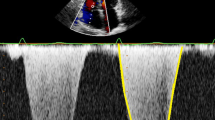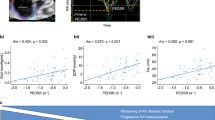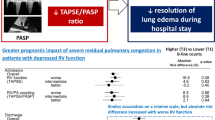Abstract
During acute pulmonary embolism (PE) a compensatory increase in right ventricular (RV) contractility is required to match increased afterload to maintain right ventricular-pulmonary arterial (RV-PA) coupling. The aim of this study was to assess the prognostic utility of RV-PA decoupling in acute PE. We assessed the association between measures of transthoracic echocardiography (TTE)-derived RV-PA coupling including tricuspid annular plane systolic excursion (TAPSE)/right ventricular systolic pressure (RVSP) and right ventricular fractional area change (FAC)/RVSP as well as stroke volume index (SVI)/RVSP (a measure of pulmonary artery capacitance) with adverse PE-related events (in-hospital PE-related mortality or cardiopulmonary decompensation) using logistic regression analysis. In 820 normotensive patients TTE-derived markers of RV-PA coupling were associated with PE-related adverse events. For each 0.1 mm/mmHg decrease in TAPSE/RVSP the odds of an adverse event increased by 2.5-fold [adjusted OR (aOR) 2.49, 95% confidence interval (CI) 1.46–4.24, p = 0.001], for every 0.1%/mmHg decrease in FAC/RVSP the odds of an adverse event increased by 1.4-fold (aOR 1.42, CI 1.09–1.86, p = 0.010), and for every 0.1 mL/mmHg m2 decrease in SVI/RVSP the odds of an event increased by 2.75-fold (aOR 2.78, CI 1.72–4.50, p < 0.001). In multivariable analysis, TAPSE/RVSP and SVI/RVSP were independent of other risk stratification methods including computed tomography-derived right ventricular dysfunction (RVD), the Bova score, and subjective assessment of TTE-derived RVD. In patients with normotensive acute PE, TTE-derived measures of RV-PA coupling are associated with adverse in-hospital PE-related events and provide incremental value in the risk assessment beyond computed tomography-derived RVD, the Bova score, or subjective TTE-derived RVD.


Similar content being viewed by others
References
Goldhaber SZ, Elliott CG (2003) Acute pulmonary embolism: part I: epidemiology, pathophysiology, and diagnosis. Circulation 108:2726–2729. https://doi.org/10.1161/01.Cir.0000097829.89204.0c
Jentzer JC, Anavekar NS, Reddy YNV, Murphree DH, Wiley BM, Oh JK et al (2021) Right ventricular pulmonary artery coupling and mortality in cardiac intensive care unit patients. J Am Heart Assoc 10:e019015. https://doi.org/10.1161/JAHA.120.019015
Konstantinides SV, Meyer G, Becattini C, Bueno H, Geersing G-J, Harjola V-P et al (2019) ESC guidelines for the diagnosis and management of acute pulmonary embolism developed in collaboration with the European Respiratory Society (ERS): the task force for the diagnosis and management of acute pulmonary embolism of the European Society of Cardiology (ESC). Eur Heart J 41:543–603. https://doi.org/10.1093/eurheartj/ehz405
Marti C, John G, Konstantinides S, Combescure C, Sanchez O, Lankeit M et al (2015) Systemic thrombolytic therapy for acute pulmonary embolism: a systematic review and meta-analysis. Eur Heart J 36:605–614. https://doi.org/10.1093/eurheartj/ehu218
Meyer G, Vicaut E, Danays T, Agnelli G, Becattini C, Beyer-Westendorf J et al (2014) Fibrinolysis for patients with intermediate-risk pulmonary embolism. N Engl J Med 370:1402–1411. https://doi.org/10.1056/NEJMoa1302097
Cho JH, Kutti Sridharan G, Kim SH, Kaw R, Abburi T, Irfan A et al (2014) Right ventricular dysfunction as an echocardiographic prognostic factor in hemodynamically stable patients with acute pulmonary embolism: a meta-analysis. BMC Cardiovasc Disord 14:64. https://doi.org/10.1186/1471-2261-14-64
Barco S, Mahmoudpour SH, Planquette B, Sanchez O, Konstantinides SV, Meyer G (2019) Prognostic value of right ventricular dysfunction or elevated cardiac biomarkers in patients with low-risk pulmonary embolism: a systematic review and meta-analysis. Eur Heart J 40:902–910. https://doi.org/10.1093/eurheartj/ehy873
Ciurzyński M, Kurnicka K, Lichodziejewska B, Kozłowska M, Pływaczewska M, Sobieraj P et al (2018) Tricuspid Regurgitation Peak Gradient (TRPG)/Tricuspid Annulus Plane Systolic Excursion (TAPSE)—a novel parameter for stepwise echocardiographic risk stratification in normotensive patients with acute pulmonary embolism. Circ J 82:1179–1185. https://doi.org/10.1253/circj.CJ-17-0940
Kamran H, Hariri EH, Iskandar JP, Sahai A, Haddadin I, Harb SC et al (2021) Simultaneous pulmonary artery pressure and left ventricle stroke volume assessment predicts adverse events in patients with pulmonary embolism. J Am Heart Assoc 10:e019849. https://doi.org/10.1161/JAHA.120.019849
Falsetti L, Marra AM, Zaccone V, Sampaolesi M, Riccomi F, Giovenali L et al (2022) Echocardiographic predictors of mortality in intermediate-risk pulmonary embolism. Intern Emerg Med. https://doi.org/10.1007/s11739-021-02910-w
Lyhne MD, Kabrhel C, Giordano N, Andersen A, Nielsen-Kudsk JE, Zheng H et al (2020) The echocardiographic ratio tricuspid annular plane systolic excursion/pulmonary arterial systolic pressure predicts short-term adverse outcomes in acute pulmonary embolism. Eur Heart J 22:285–294. https://doi.org/10.1093/ehjci/jeaa243
Bajaj A, Rathor P, Sehgal V, Kabak B, Shetty A, Al Masalmeh O et al (2015) Prognostic value of biomarkers in acute non-massive pulmonary embolism: a systematic review and meta-analysis. Lung 193:639–651. https://doi.org/10.1007/s00408-015-9752-4
Meinel FG, Nance JW Jr, Schoepf UJ, Hoffmann VS, Thierfelder KM, Costello P et al (2015) Predictive value of computed tomography in acute pulmonary embolism: systematic review and meta-analysis. Am J Med 128:747–59.e2. https://doi.org/10.1016/j.amjmed.2015.01.023
Bova C, Sanchez O, Prandoni P, Lankeit M, Konstantinides S, Vanni S et al (2014) Identification of intermediate-risk patients with acute symptomatic pulmonary embolism. Eur Respir J 44:694–703. https://doi.org/10.1183/09031936.00006114
Prosperi-Porta G, Solverson K, Fine N, Humphreys CJ, Ferland A, Weatherald J (2020) Echocardiography-derived stroke volume index is associated with adverse in-hospital outcomes in intermediate-risk acute pulmonary embolism: a retrospective Cohort Study. Chest 158:1132–1142. https://doi.org/10.1016/j.chest.2020.02.066
Solverson K, Humphreys C, Liang Z, Prosperi-Porta G, Andruchow JE, Boiteau P et al (2021) Rapid prediction of adverse outcomes for acute normotensive pulmonary embolism: derivation of the Calgary Acute Pulmonary Embolism (CAPE) score. ERJ Open Res. https://doi.org/10.1183/23120541.00879-2020
Jiménez D, Aujesky D, Moores L, Gómez V, Lobo JL, Uresandi F et al (2010) Simplification of the pulmonary embolism severity index for prognostication in patients with acute symptomatic pulmonary embolism. Arch Intern Med 170:1383–1389. https://doi.org/10.1001/archinternmed.2010.199
Mitchell C, Rahko PS, Blauwet LA, Canaday B, Finstuen JA, Foster MC et al (2019) Guidelines for performing a comprehensive transthoracic echocardiographic examination in adults: recommendations from the American Society of Echocardiography. J Am Soc Echocardiogr 32:1–64. https://doi.org/10.1016/j.echo.2018.06.004
Lang RM, Badano LP, Mor-Avi V, Afilalo J, Armstrong A, Ernande L et al (2015) Recommendations for cardiac chamber quantification by echocardiography in adults: an update from the American Society of Echocardiography and the European Association of cardiovascular imaging. J Am Soc Echocardiogr 28:1-39.e14. https://doi.org/10.1016/j.echo.2014.10.003
Rudski LG, Lai WW, Afilalo J, Hua L, Handschumacher MD, Chandrasekaran K et al (2010) Guidelines for the echocardiographic assessment of the right heart in adults: a report from the American Society of Echocardiography endorsed by the European Association of Echocardiography, a registered branch of the European Society of Cardiology, and the Canadian Society of Echocardiography. J Am Soc Echocardiogr 23:685–713. https://doi.org/10.1016/j.echo.2010.05.010
Schmeisser A, Rauwolf T, Groscheck T, Kropf S, Luani B, Tanev I et al (2021) Pressure-volume loop validation of TAPSE/PASP for right ventricular arterial coupling in heart failure with pulmonary hypertension. Eur Heart J Cardiovasc Imaging 22:168–176. https://doi.org/10.1093/ehjci/jeaa285
Tello K, Wan J, Dalmer A, Vanderpool R, Ghofrani HA, Naeije R et al (2019) Validation of the tricuspid annular plane systolic excursion/systolic pulmonary artery pressure ratio for the assessment of right ventricular-arterial coupling in severe pulmonary hypertension. Circ Cardiovasc Imaging 12:e009047. https://doi.org/10.1161/circimaging.119.009047
Guazzi M, Dixon D, Labate V, Beussink-Nelson L, Bandera F, Cuttica MJ et al (2017) RV contractile function and its coupling to pulmonary circulation in heart failure with preserved ejection fraction: stratification of clinical phenotypes and outcomes. JACC Cardiovasc Imaging 10:1211–1221. https://doi.org/10.1016/j.jcmg.2016.12.024
Tello K, Ghofrani HA, Heinze C, Krueger K, Naeije R, Raubach C et al (2019) A simple echocardiographic estimate of right ventricular-arterial coupling to assess severity and outcome in pulmonary hypertension on chronic lung disease. Eur Respir J. https://doi.org/10.1183/13993003.02435-2018
Tello K, Axmann J, Ghofrani HA, Naeije R, Narcin N, Rieth A et al (2018) Relevance of the TAPSE/PASP ratio in pulmonary arterial hypertension. Int J Cardiol 266:229–235. https://doi.org/10.1016/j.ijcard.2018.01.053
Papolos A, Fan E, Wagle RR, Foster E, Boyle AJ, Yeghiazarians Y et al (2019) Echocardiographic determination of pulmonary arterial capacitance. Int J Cardiovasc Imaging 35:1581–1586. https://doi.org/10.1007/s10554-019-01595-9
Youden WJ (1950) Index for rating diagnostic tests. Cancer 3:32–35. https://doi.org/10.1002/1097-0142(1950)3:1%3c32::aid-cncr2820030106%3e3.0.co;2-3
Tedford RJ, Hassoun PM, Mathai SC, Girgis RE, Russell SD, Thiemann DR et al (2012) Pulmonary capillary wedge pressure augments right ventricular pulsatile loading. Circulation 125:289–297. https://doi.org/10.1161/CIRCULATIONAHA.111.051540
Vonk-Noordegraaf A, Haddad F, Chin KM, Forfia PR, Kawut SM, Lumens J et al (2013) Right heart adaptation to pulmonary arterial hypertension: physiology and pathobiology. J Am Coll Cardiol 62:D22-33. https://doi.org/10.1016/j.jacc.2013.10.027
Wang Z, Chesler NC (2011) Pulmonary vascular wall stiffness: an important contributor to the increased right ventricular afterload with pulmonary hypertension. Pulm Circ 1:212–223. https://doi.org/10.4103/2045-8932.83453
Jakobsen JC, Gluud C, Wetterslev J, Winkel P (2017) When and how should multiple imputation be used for handling missing data in randomised clinical trials—a practical guide with flowcharts. BMC Med Res Methodol 17:162. https://doi.org/10.1186/s12874-017-0442-1
Funding
The authors declare that no funds, grants, or other support were received during the preparation of this manuscript.
Author information
Authors and Affiliations
Contributions
All authors contributed to the study conception and design. Material preparation, data collection and analysis were performed by OK, KS, GPP, and JW. The first draft of the manuscript was written by OK and GPP and all authors commented on previous versions of the manuscript. All authors read and approved the final manuscript.
Corresponding author
Ethics declarations
Conflict of interest
The authors have no relevant financial or non-financial interests to disclose.
Additional information
Publisher's Note
Springer Nature remains neutral with regard to jurisdictional claims in published maps and institutional affiliations.
Rights and permissions
About this article
Cite this article
Kiamanesh, O., Prosperi-Porta, G., Harper, L. et al. Ventricular-arterial decoupling is associated with in-hospital adverse events in normotensive pulmonary embolism. Int J Cardiovasc Imaging 38, 2655–2665 (2022). https://doi.org/10.1007/s10554-022-02677-x
Received:
Accepted:
Published:
Issue Date:
DOI: https://doi.org/10.1007/s10554-022-02677-x




